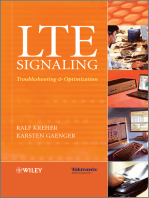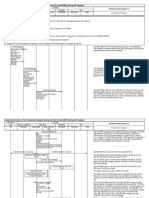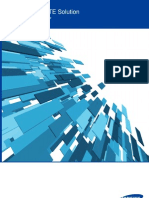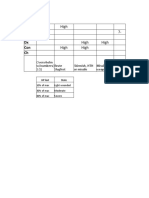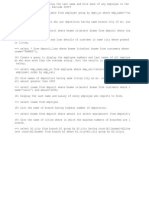Volte SRVCC
Volte SRVCC
Uploaded by
monel_24671Copyright:
Available Formats
Volte SRVCC
Volte SRVCC
Uploaded by
monel_24671Original Title
Copyright
Available Formats
Share this document
Did you find this document useful?
Is this content inappropriate?
Copyright:
Available Formats
Volte SRVCC
Volte SRVCC
Uploaded by
monel_24671Copyright:
Available Formats
Copyright ANRITSU
2014-07
VoLTE and SRVCC
Copyright ANRITSU
Agenda
Overview of LTE
IMS Network
Standards and Test Requirements
VoLTE, Call Continuity, and IMS Services (RCS)
VoLTE vs VoIP and Other Solutions
VoLTE in Detail
Mobility/Call Continuity (SRVCC)
IMS Services (RCS)
Anritsu Solutions for VoLTE and Call Continuity
Anritsu Products Supporting New Features and Requirements
Copyright ANRITSU
LTE-SAE/EPC System Architecture
E-UTRAN
2G/3G
UTRAN
WiFi 1xEV-DO
EPC
Operator
Services
HSS
MME
PCRF
SGSN
ePDG
S-GW
P-GW/PCEF
Copyright ANRITSU
System Architecture Evolution (SAE)
Synonymous with Evolved Packet Core (EPC)
ALL IP Architecture
Key Features:
Higher data rates and Reduce Latency
Multi-RAT Support
Allows integration of Non-3GPP networks
Optimized for all IP services
http://www.3gpp.org/technologies/keywords-acronyms/100-the-evolved-packet-core
Copyright ANRITSU
LTE-EPC Network Nodes
MME (Mobility Management Entity)
UE Mobility Control
Security
Authentication
Bearer path control
HSS (Home Subscriber Server)
Master Subscriber Database that stores:
User ID
Numbering and service/subscription profiles
Generates security relation information
MME
HSS
S6a (3Gpp 29.272)
Copyright ANRITSU
LTE-SAE/EPC System Architecture
S-GW (Serving Gateway)
Routes data packets between the P-GW and E-UTRAN
Buffers downlink data during paging operations
P-GW (Packet Data Network Gateway)
Default router to the UE providing IP assignment/PDN
Connectivity
Handles mobility between 3GPP/non-3GPP access
systems
QoS/Policy enforcement/charging/lawful interception
PCRF (Policy and Charging Rules
Function)
Policy and Charging Enforcement Function
S-GW
P-GW/PCEF
PCRF
Copyright ANRITSU
IMS Development & History
Developed by the cellular industry to meet growing needs
across the mobile, fixed and IT/computing networks
Designed to allow ubiquitous access to multimedia
services from an access terminal
IMS Standards were developed by 3G.IP formed in 1999,
which is now taken over by 3GPP
In 2010, GSMA announced at MWC that they were
supporting the One World initiative for carrying Voice
over LTE (VoLTE)
Operators decided to incorporate IMS capabilities
Copyright ANRITSU
IMS Network Architecture
MRFP
AS
HSS
S-CSCF
I-CSCF
MRFC
EPC
PGW
PCRF
P-CSCF
MGCF
MGW
TrGW
BGCF
IBCF
Internet
Media
PSTN
Copyright ANRITSU
Call Session Control Functions
Proxy CSCF (P-CSCF)
Provides IMS access to
mobiles/Forwards SIP messages
between mobile and a S-CSCF
Emergency Services
Security and QoS
Compression of SIP messages
Interrogating CSCF (I-CSCF)
Selects S-CSCF
Provides Load Distribution
Serving CSCF (S-CSCF)
Acts as a SIP registrar and the
primary call server for certain
registered UEs
Copyright ANRITSU
Additional IMS Functions
Media Gateway Control Function
Controls Media Gateways
Translates signaling messages (converts SIP to
ISUP)
Breakout Gateway Control
Function
SIP proxy between the S-CSCF and MGCF
Selects MGCF based on destination network
Determines PSTN breakout point
Chooses MGCF in its own network/Routes
requests to BGCF in a different network
Application Servers
Local SIP AS, OSA-SCS, and IM-SSF
Copyright ANRITSU
Putting it ALL Together
Copyright ANRITSU
Voice over LTE (VoLTE)
Why VoLTE?
LTE is seen as IP only system for data
Operators chose to carry voice over 2G/3G systems or VoIP in one form or
the other
This would lead to fragmentation and incompatibility not allowing all
phones to communicate with each other
VoLTE Formation
The system is based on the IMS MMTel concepts and are specified in the
GSMA IR.92
Copyright ANRITSU
Other Options for VoLTE
Circuit Switch Fallback (CSFB/1xeCSFB)
Data over LTE and when required voice (CS) services will fallback to
2G/3G
Simultaneous Voice LTE (SVLTE)
Requires 2 radios
Data Only over LTE and Voice (CS) services over 1x
Voice over LTE via GAN (VoLGA)
Based on existing 3gpp Generic Access Network
Aim to enable LTE users to receive consistent voice/SMS (CS) services
while transitioning between GSM, UMTS and LTE
Dual SIM
Copyright ANRITSU
VoLTE Challenges
Meeting end user expectations
Supplementary Services must work as current 2G/3G CS networks
Mobility/Roaming Interoperability between LTE and 2G/3G
networks
Regulatory Requirements (Emergency Calls)
Copyright ANRITSU
Motivation for VoLTE
VoIP Applications
Data streams of these applications are not
differentiated from other IP data traffic
No QoS
VoLTE
Uses LTE prioritization to deliver consistent QoS
Enables features users are accustomed to in their
2G/3G devices
Copyright ANRITSU
Why VoLTE over VoIP?
VoLTE
Guaranteed QoS
IMS
RAN Features
Semi Persistent Scheduling (SPS)
Transmission Time Interval (TTI)
Discontinuous Transmission (DRx)
Robust Header Compression
(RoHC)
VoIP
Best- Effort
Generic IP Network
Carrier
Grade!
Copyright ANRITSU
Key VoLTE/IMS Specifications
3GPP
TS 23.216 SRVCC Stage 2
TS 23.228 IMS Stage 2
TS 23.237 IMS Service
Continuity Stage 2
TS 23.292 IMS Centralized
Services Stage 2
TS 24.237 IMS Service
Continuity
TS 26.132 PESQ/POLQA
http://www.3gpp.org
GSMA
IR.92 IMS Profile for Voice
and SMS
IR.64 IMS Service
Centralization and Continuity
Guidelines
IR.94 Video Call Support
IR.65 IMS Roaming and
Interworking Guidelines
IR.88 LTE Roaming
Guidelines
http://www.gsma.com
Copyright ANRITSU
GSMA PRD IR.92
IMS Profile for Voice and SMS
A profile as opposed to a technical specification
Defines how the facilities already defined by 3GPP should be used to
ensure interoperability across various operators networks
Copyright ANRITSU
GSMA IR.92 v7.0 Focus Areas
IMS Feature Set
SIP Registration Procedures
Authentication
Call Establishment and Termination
Forking
Signaling Compression
SMS over IP
Supplementary Services
Multi Party Conference
Communication Waiting
Message Waiting Indication
Communication Diversion
Communication Barring
IMS Media
Codecs
RTP Profile and SDP Considerations
RTCP Usage
AMR Payload Format Considerations
Jitter Buffer Management Considerations
DTMF Events
Radio and Packet Core Feature Set
Robust Header Compression
Radio Bearer and RLC configurations
DRX Mode of Operation
GBR and NGBR Services and Monitoring
EPS Bearer Considerations for
SIP Signaling
XCAP
Voice
Copyright ANRITSU
GSMA PRD IR.64 v6.0
IMS Service Centralization and Continuity Guidelines
Centralization / Anchoring of services in the IMS Core
Continuity of service for single radio devices when access network
changes
Adds to the guidelines defined in IR.92
Focus Areas
Network based
solution
SRVCC from
LTE/HSPA to
GERAN/UTRAN
UE-based solution
and other service
continuity scenarios
are out of scope
Copyright ANRITSU
SIP and SDP
Session Initiation Protocol (SIP)
Signaling protocol used for controlling multimedia communication
sessions in IP networks
Defined in RFC 3261
Application protocol designed to be independent of the underlying
transport layer
Session Description Protocol (SDP)
Responsible for session description
Transported in SIP message
Copyright ANRITSU
VoLTE Pre-Call
IMS PDN Connection
Provides connection to one or more IP networks for services
For VoLTE UE will require connection to operators IMS-based services
network (PDN_ID/APN for the IMS network would be in the subscription
information in the HSS)
IMS PDN
EPS
PGW
SIP Signaling and
Voice Packets
Copyright ANRITSU
Initial VoLTE Registration
visited.net
S-CSCF
I-CSCF
P-CSCF
HOME.net
1. Proxy CSCF Discovery
9. Service Control
7. Profile Retrieval
6. Subscriber Authentication
5. S-CSCF Selection
3. I-CSCF Discovery
2. REGISTER
8. 200 OK (Register Successful)
4. REGISTER
Copyright ANRITSU
VoLTE Basic CallFlow
User1
User2
INVITE
AMR, AMR-WB
Local QoS unsatisfied
183 Session Progress
AMR-WB, AMR
Local QoS unsatisfied
PRACK
AMR
Local QoS unsatisfied
200 OK
AMR
Local QoS unsatisfied
Final Decision
(AMR)
Request Resources Request Resourses
Copyright ANRITSU
EPS Bearers for IMS VoIP
Default EPS Bearer
Default Connectivity for IMS Signaling
Dedicated EPS Bearer
Additional Bearer for
VoIP or Video Traffic
EPS
IMS PDN
One PDN connection for IMS VoIP calls with more than
one EPS bearer
One IP address is used for PDN Connection
Each EPS bearer will have defined QoS Characteristics
Copyright ANRITSU
VoLTE Mobility
Copyright ANRITSU
IMS Service Continuity
Allows user to transfer media sessions across different access networks or UEs
Example: transfer ongoing media session from mobile device to TV
Sessions can be transferred as a whole (for example voice and video) or in part
User can add/delete sessions on multiple devices, controlled from a single device
Even control of a collaborative session can transfer from one user to another
Copyright ANRITSU
IMS Centralized Services (ICS)
Provides the same services
regardless of access network:
CS or PS
Users get new IMS services
while still using CS domain for
the media bearer
IMS sessions on CS bearers
treated like any other full IMS
session
All services provided by IMS
application servers and
controlled by IMS service control
architecture
Adds supplementary services to
VCC
Copyright ANRITSU
SRVCC For VoLTE
Single Radio Voice Call Continuity (SRVCC)
Copyright ANRITSU
IMS Services - RCS
Rich Communication Services
Designed to offer richer yet simpler communication
services supported by a strong ecosystem and a
variety of architecture implementation options
Main Features:
Enhanced Phonebook: service capabilities and
enhanced contacts informations such as presence and
service discovery
Enhanced Messaging: enables a large variety of
messaging options including chat, emoticons, location
share and file sharing
Enriched Calls: enables multimedia content sharing
during a voice call, video call and video sharing
Reference: http://en.wikipedia.org/wiki/Rich_Communication_Services
Copyright ANRITSU
RCS v5.1 Feature Set
Copyright ANRITSU
Anritsu MD8430/8480 Solution
Copyright ANRITSU
Addresses Technology Challenges
IMS Signaling over LTE Transport
Test IMS protocols over the LTE radio interface
CSFB and SRVCC
Built in test cases
Over 100 example tests
IR.92, IR.94, PRS, XDM, AMR, H.264, etc
Rich Communication Services
Presence, Instant messaging, file transfer
Address book, XML Document Management (XDM)
XCAP server simulation
IMS Emergency Calls
Copyright ANRITSU
Media Quality Testing
Voice/Audio Quality
MOS
PESQ
Video
No-Reference (online)
Full Reference
Audio Video
No-Reference
Offline
ITU G.107 ITU G.107
ITU-R BT.500.9
Full-Reference
Offline
PESQ
ITU P.862 (also
available online)
ITU J.247 (unique
synchronization
algorithm)
No-Reference
Online
ITU G.107 ITU G.107
ITU-R BT.500.9
Copyright ANRITSU
Anritsu MD8475 Solution
Copyright ANRITSU
Tests Performed On MD8475
IMS registration
IMS security procedures
Device (SIP) addressing
Call processing including
abnormal call handling
Call conferencing
and supplementary services
such as call forwarding
Call drop and reestablishment
Emergency calls
SRVCC
Copyright ANRITSU
RCS On MD8475
IMS Core
Presence server
XDM server IM server
RCS server component
3GGP
Network
MX847570A-083 RCS Basic Option
Configuration/registration
Social Presence
1-to-1 chat
Capability discovery
MX847570A SmartStudio - IMS Services
CSCF
XCAP
* New MX847570A-083 RCS Basic Option required
Key Value for Customer
Users can test each service RCS 5.1 which needs
some servers with one box.
Target customer is leading-edge UE vendor which
develops for special operators.
Copyright ANRITSU
RCS 5.1 Service Support
Item Support Future Comment
Configuration & Registration
(*1)
(*1)
(*1) Support only HTTP(S) base
Capability discovery
Standalone messaging
1-to-1 Chat
(*2, 3)
(*2) Support only IM. Not support CPM.
(*3) Interaction with other RCS service is not supported.
Group Chat
File Transfer
Content sharing
Social Presence Information
(*4)
(*4) Not supported geolocation service.
IP Voice Call
(*5, 6)
(*5, 6)
(*5) Support only IR.92 base
(*6) Interaction with other RCS service is not supported.
IP Video Call (IR.94)
(*7, 8)
(*7, 8)
(*7) Support only IR.94 base
(*8) Interaction with other RCS service is not supported.
Geolocation services
(*9)
(*9) Interaction with other RCS service is not supported.
Copyright ANRITSU
Anritsu ME7834L Solution
Copyright ANRITSU
3GPP and CAT
Conformance
36.521-1 RF
36.521-3 RRM
36.523-1 Protocol
37.571-1 Emergency Calls
Test suites covering ancillary
functionality such as the UICC
Carrier-specific test plans
ATT
T-Mobile
Verizon
Others
2G/3G Simulators
LTE Simulators
Test
Controller
*Example configuration
Supporting
Components
Copyright ANRITSU
Conclusion
LTE EPC and IMS Networks are Complex
New Specifications and Recommendations
Including Signaling; Media; Services
Service Continuity SRVCC
RCS (Rich Communication Services)
Service Continuity is Important
SRVCC (GSMA indicates 3GPP Rel10 for initial rollouts)
Anritsu Products Meet the Challenges
Several different configurations based on needs of customer
You might also like
- Dragon Harvest - GM BinderDocument7 pagesDragon Harvest - GM Bindermonel_24671No ratings yet
- Mobile Network Optimization: A Guide for 2G and 3G Mobile Network OptimizationFrom EverandMobile Network Optimization: A Guide for 2G and 3G Mobile Network OptimizationRating: 3.5 out of 5 stars3.5/5 (3)
- 03 IMS Registration and DeregistrationDocument42 pages03 IMS Registration and Deregistrationhela2709No ratings yet
- LTE Protocol Stack TestingDocument2 pagesLTE Protocol Stack Testingmohdwajid200950% (4)
- Essential 4G Guide: Learn 4G Wireless In One DayFrom EverandEssential 4G Guide: Learn 4G Wireless In One DayRating: 4.5 out of 5 stars4.5/5 (12)
- From GSM to LTE-Advanced Pro and 5G: An Introduction to Mobile Networks and Mobile BroadbandFrom EverandFrom GSM to LTE-Advanced Pro and 5G: An Introduction to Mobile Networks and Mobile BroadbandNo ratings yet
- Volte Signaling Presentation: Huawei Technologies Co. LTDDocument37 pagesVolte Signaling Presentation: Huawei Technologies Co. LTDJitendra Asati100% (1)
- LTE Signaling: Troubleshooting and OptimizationFrom EverandLTE Signaling: Troubleshooting and OptimizationRating: 3.5 out of 5 stars3.5/5 (2)
- Google AdsDocument8 pagesGoogle AdsKeeru Boss100% (2)
- Sewogue k12 Ny uscommonpagesDisplayFile Aspxitemid 24257823 PDFDocument30 pagesSewogue k12 Ny uscommonpagesDisplayFile Aspxitemid 24257823 PDFAlyssa DevauxNo ratings yet
- VoLTE and SRVCC PDFDocument41 pagesVoLTE and SRVCC PDFebruNo ratings yet
- LTE Self-Organising Networks (SON): Network Management Automation for Operational EfficiencyFrom EverandLTE Self-Organising Networks (SON): Network Management Automation for Operational EfficiencySeppo HämäläinenNo ratings yet
- LTE Call FlowDocument35 pagesLTE Call FlowNanda Kumar100% (3)
- VoLTE Call Flow and ProceduresDocument11 pagesVoLTE Call Flow and Proceduresaggarwal.samrat245100% (3)
- VoLTE Overview and PerformanceDocument21 pagesVoLTE Overview and PerformanceVictor Perez Jimenez0% (1)
- Section 8: Inter-RAT Handover: Single Radio Voice Call Continuity (SRVCC)Document19 pagesSection 8: Inter-RAT Handover: Single Radio Voice Call Continuity (SRVCC)Aseem Rajpal100% (2)
- VoLTE Optimization - Session 1Document39 pagesVoLTE Optimization - Session 1Jashwanth Reddy MuskiNo ratings yet
- Definitions:-: CSFB (Circuit Switched Fallback) :-Is A Functionality Specified by 3GPP To Provide Legacy CircuitDocument12 pagesDefinitions:-: CSFB (Circuit Switched Fallback) :-Is A Functionality Specified by 3GPP To Provide Legacy CircuitFauzi Hidayat100% (1)
- Understanding Call Flow inDocument19 pagesUnderstanding Call Flow inBraj Bhushan100% (1)
- 1 VoLTE Solution Overview ISSUE 1.00Document70 pages1 VoLTE Solution Overview ISSUE 1.00Wael AlkodamiNo ratings yet
- Lte Tracking Area UpdateDocument3 pagesLte Tracking Area Updatesagarnewase100% (1)
- E2E VoLTE Call SetupDocument28 pagesE2E VoLTE Call SetupBikash Dash100% (2)
- VoLTE Call Setup Flow - PDN ConnectionDocument29 pagesVoLTE Call Setup Flow - PDN Connectionumts12345100% (20)
- VoLTE E2E Analysis Troubleshooting ToolsDocument23 pagesVoLTE E2E Analysis Troubleshooting ToolsPooneh Parvin83% (6)
- E2E Volte Optimization-Offerings & Capabilities: Planning & Implementation Testing & ToolsDocument15 pagesE2E Volte Optimization-Offerings & Capabilities: Planning & Implementation Testing & Toolsvallala venkateshNo ratings yet
- Volte CallsetupDocument121 pagesVolte CallsetupMenard Cruz80% (5)
- VoLTE - E2E Message FlowsDocument42 pagesVoLTE - E2E Message Flowssaurabh singhNo ratings yet
- Basic LTE Call Flow: LTE A Terminal Must Perform Certain StepsDocument9 pagesBasic LTE Call Flow: LTE A Terminal Must Perform Certain StepsAnonymous SuO1HHNo ratings yet
- LTE Attach ProcedureDocument34 pagesLTE Attach Proceduremd1234_1984100% (3)
- 22 VoLTE Call Steps FiDocument309 pages22 VoLTE Call Steps FiSri Krishnan100% (1)
- 02 LTE Signaling and ProtocolsDocument148 pages02 LTE Signaling and ProtocolsTinh Dong100% (2)
- VoLTE Solution OverviewDocument70 pagesVoLTE Solution OverviewHassan Abd El Fattah100% (1)
- Sip Call FlowsDocument9 pagesSip Call Flowsamit_tomar_amit0% (1)
- Lte AttachDocument3 pagesLte AttachsagarnewaseNo ratings yet
- CSFB To 2G 3G - E2E Message FlowsDocument21 pagesCSFB To 2G 3G - E2E Message FlowsJamel Siagian100% (2)
- VolteDocument13 pagesVoltedcute_bgtNo ratings yet
- Troubleshooting VoLTE &Document3 pagesTroubleshooting VoLTE &Ambuj0% (1)
- Carrier Aggregation in LTE-AdvancedDocument32 pagesCarrier Aggregation in LTE-AdvancedRockson Kwame Agyeman67% (3)
- Apple VoLTE Certificate Assurance-Analysis&Optimization For VoLTE Call DropDocument18 pagesApple VoLTE Certificate Assurance-Analysis&Optimization For VoLTE Call DropBelieverNo ratings yet
- LTE - Handover & Mobility OverviewDocument11 pagesLTE - Handover & Mobility OverviewDhariwalSandeep100% (1)
- Analyzing and Troubleshooting VoLTEDocument10 pagesAnalyzing and Troubleshooting VoLTEfebrie.milaNo ratings yet
- SRVCC From LTe and CSFB With HODocument23 pagesSRVCC From LTe and CSFB With HOBinance FuturesGeo50% (2)
- Lte Protocol Stack Mac RLC PDCPDocument42 pagesLte Protocol Stack Mac RLC PDCPAtul DeshpandeNo ratings yet
- Samsung Case Smart VoLTE SolutionDocument11 pagesSamsung Case Smart VoLTE SolutionlcardonagNo ratings yet
- Lte RRCDocument56 pagesLte RRCPriya S100% (2)
- CSFB Call Flow - LTEDocument19 pagesCSFB Call Flow - LTEUrvin Shah33% (3)
- VoLTE and ViLTE: Voice and Conversational Video Services over the 4G Mobile NetworkFrom EverandVoLTE and ViLTE: Voice and Conversational Video Services over the 4G Mobile NetworkNo ratings yet
- Fundamentals of Cellular Network Planning and Optimisation: 2G/2.5G/3G... Evolution to 4GFrom EverandFundamentals of Cellular Network Planning and Optimisation: 2G/2.5G/3G... Evolution to 4GNo ratings yet
- Fundamentals of Network Planning and Optimisation 2G/3G/4G: Evolution to 5GFrom EverandFundamentals of Network Planning and Optimisation 2G/3G/4G: Evolution to 5GNo ratings yet
- The LTE-Advanced Deployment Handbook: The Planning Guidelines for the Fourth Generation NetworksFrom EverandThe LTE-Advanced Deployment Handbook: The Planning Guidelines for the Fourth Generation NetworksRating: 5 out of 5 stars5/5 (3)
- Spell Name Metamagic Effect Metamagic Component Minimum CostDocument14 pagesSpell Name Metamagic Effect Metamagic Component Minimum Costmonel_24671No ratings yet
- Force Missile MageDocument2 pagesForce Missile Magemonel_24671No ratings yet
- DND 3.5 - Practical Guide To FamiliarsDocument19 pagesDND 3.5 - Practical Guide To Familiarsmonel_24671No ratings yet
- Nokia Motive Service Management PlatformDocument4 pagesNokia Motive Service Management Platformmonel_24671No ratings yet
- DND 3.5 - Practical Guide To MetamagicDocument4 pagesDND 3.5 - Practical Guide To Metamagicmonel_24671No ratings yet
- Potion Taste ChartDocument4 pagesPotion Taste Chartmonel_24671No ratings yet
- Axon Body 3 User ManualDocument44 pagesAxon Body 3 User Manualmonel_24671No ratings yet
- ST IQ Wis DX Con CH: Low High 7-High High High HighDocument2 pagesST IQ Wis DX Con CH: Low High 7-High High High Highmonel_24671No ratings yet
- DND 3.5 - Sorcerer Wizard Supremacy Caster Spell ListDocument10 pagesDND 3.5 - Sorcerer Wizard Supremacy Caster Spell Listmonel_24671No ratings yet
- Test Considerations of 5GDocument9 pagesTest Considerations of 5Gmonel_24671No ratings yet
- Dynamic Spectrum Sharing: Driving 5G To Scale: by Sean KinneyDocument16 pagesDynamic Spectrum Sharing: Driving 5G To Scale: by Sean Kinneymonel_24671100% (1)
- White Paper: 5G Evolution: On The Path To 6GDocument47 pagesWhite Paper: 5G Evolution: On The Path To 6Gmonel_24671No ratings yet
- Cell Coverage Buyers GuideDocument23 pagesCell Coverage Buyers Guidemonel_24671No ratings yet
- Replacing CMU With CMW in 2G & 3G Speech TestingDocument14 pagesReplacing CMU With CMW in 2G & 3G Speech Testingmonel_24671No ratings yet
- An Introduction To O-RAN: White PaperDocument8 pagesAn Introduction To O-RAN: White Papermonel_24671No ratings yet
- OTA Setup For 5G TF Beamforming Functional TestsDocument8 pagesOTA Setup For 5G TF Beamforming Functional Testsmonel_24671No ratings yet
- Radio Fundamentals For Cellular NetworksDocument40 pagesRadio Fundamentals For Cellular Networksmonel_24671100% (1)
- R2.0 MN-COM1S TCPIP To RS232 Interface Installation SheetDocument4 pagesR2.0 MN-COM1S TCPIP To RS232 Interface Installation SheetRaviNo ratings yet
- Near Field Communication (NFC) : Hussein Ahmad Al-Ofeishat, Mohammad A.A.Al RababahDocument7 pagesNear Field Communication (NFC) : Hussein Ahmad Al-Ofeishat, Mohammad A.A.Al RababahGuillermo Vázquez GonzálezNo ratings yet
- Alexander Installation and Configuration Guide1 - 6Document16 pagesAlexander Installation and Configuration Guide1 - 6SkrapNo ratings yet
- Core Switch For Metro Ethernet Backbone Networks: High Capacity Carrier EthernetDocument4 pagesCore Switch For Metro Ethernet Backbone Networks: High Capacity Carrier Ethernetsalic2013No ratings yet
- Phone Service Browser Web BrowserDocument3 pagesPhone Service Browser Web Browserrudy_423522658No ratings yet
- LivitDocument11 pagesLivitJansen JacobNo ratings yet
- Error Code Printer CanonDocument3 pagesError Code Printer CanonLaras Ahmad Stoedioe100% (1)
- Gtu Practical 7Document1 pageGtu Practical 7parmar shyamNo ratings yet
- TechCrunch - Font Magazine Issue 007 - For EmbeddingDocument13 pagesTechCrunch - Font Magazine Issue 007 - For Embeddings_reuterNo ratings yet
- MS-DOS Basics - A TutorialDocument56 pagesMS-DOS Basics - A TutorialSALEEMNo ratings yet
- Check Point ClearPass Integration StepsDocument2 pagesCheck Point ClearPass Integration StepsElvisNo ratings yet
- Unit-5 DSMM AKTUDocument5 pagesUnit-5 DSMM AKTUdivinepeepeeNo ratings yet
- Connecting Business. Connecting Africa.: ContactDocument43 pagesConnecting Business. Connecting Africa.: ContactlewisericrNo ratings yet
- Ico300 83bDocument2 pagesIco300 83bT AnnapooraniNo ratings yet
- User Guide: Boson Netsim OverviewDocument54 pagesUser Guide: Boson Netsim Overviewkssr_579410930No ratings yet
- Amted303030en (Web)Document2 pagesAmted303030en (Web)Andreas AndreassNo ratings yet
- Richard Proctor Network Helpdesk JuditincDocument5 pagesRichard Proctor Network Helpdesk JuditincLaxmi StaffingNo ratings yet
- GovRedirectLinks OnlyDocument2 pagesGovRedirectLinks OnlyNilnNiluNo ratings yet
- SonicwallNSA Series-FirewallDocument4 pagesSonicwallNSA Series-Firewalladah MuzakirNo ratings yet
- Artificial Intelligence - MGR UniversityDocument41 pagesArtificial Intelligence - MGR UniversityBlessyNo ratings yet
- BC - LearnEnglish-Reading-B1-How-to-spot-fake-news (ANSWERED)Document4 pagesBC - LearnEnglish-Reading-B1-How-to-spot-fake-news (ANSWERED)Roberto CalvoNo ratings yet
- Tugas Deployment 12.52.0329Document10 pagesTugas Deployment 12.52.0329putra505No ratings yet
- Design and Implementation of A Cloud-Based Iot Scheme For Precision AgricultureDocument4 pagesDesign and Implementation of A Cloud-Based Iot Scheme For Precision AgricultureHedy PamungkasNo ratings yet
- Gcia ForensicsDocument6 pagesGcia Forensicsjbrackett239No ratings yet
- Video Coding StandardsDocument14 pagesVideo Coding StandardsDavid GüeraNo ratings yet
- IT Software Solutions For Business IT Network Systems AdministrationDocument33 pagesIT Software Solutions For Business IT Network Systems AdministrationGabrielNo ratings yet
- AstrsasDocument9 pagesAstrsasDjWagner007No ratings yet
- QUESTION NUMBER 1:-Write A Program in Java Script Code For Handling Different Events. Source CodeDocument3 pagesQUESTION NUMBER 1:-Write A Program in Java Script Code For Handling Different Events. Source CodeTasleem ShaikhNo ratings yet








